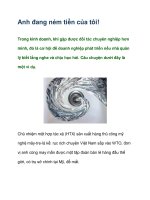Tài liệu Về dạng chuẩn Boyce-Cold của sơ đồ quan hệ potx
Bạn đang xem bản rút gọn của tài liệu. Xem và tải ngay bản đầy đủ của tài liệu tại đây (1.57 MB, 3 trang )
TI!-p chI Tin hgc.
va
fJieu khien hoc, T. 16, S. 1 (2000), 15-17
ON THE BOYCE - CODD NORMAL FORM FOR RELATION SCHEME
VU DUC THI, LUONG CAO SON
Abstract. The Boyce- Codd normal form (BCNF) is an essential normal form for relation schemes
in the relational database. This normal form has been used in designing database systems. Keys and
minimal keys are the important concepts of the relational datamodel. The set of minimal keys of
relation scheme is Sperner system. In this paper we show a new necessary and sufficient conditions for
an arbitrary relation scheme is in BCNF and its set of minimal keys is a given Sperner system.
1. INTRODUCTION
Now we start with some necessary definitions, and in the next sections we formulate our results.
Definition
1. Let
R
=
{hI, ,hn}
be a relation over
U,
and
A, B ~ U.
Then we say that
B
functionally depends on
A
in
R
(denoted
A
.L,
B)
iff
R
(Vhi' hj
E
R)(Va
E
A)(hda)
=
hj(a)) ~
(Vb
E
B)(hdb)
=
hj(b)).
Let
FR
=
{(A, B) ; A, B ~ U, A
.L;
B}.
FR
is called the full family of functional depen:dencies
R
of
R.
Where we write
(A, B)
or
A
-+
B
for
AI / R B
when
R, I
are clear from the context.
Definition
2. A functional dependency (FD) over
U
is a statement of the form
A
-+
B,
where
A, B ~ U.
The FD
A
-+
B
holds in a relation
R
if
A
.L;
B.
We alsosay that
R
satisfies the FD
R
A
-+
B.
Definition
3. Let
U
be a finite set, and denote~
P(U)
its power set. Let
Y ~ P(U)
x
P(U).
We say
that
Y
is an I-family over
U
iff for all
A, B, C, D ~ U
(1) (A, A)
E
Y,
(2J'(A, B)
E
Y, (B, C)
E
Y ~ (A, C)
E
Y,
(3) (A, B)
E
Y, A ~ C, D ~ B ~ (C, D)
E
Y,
(4) (A, B)
E
Y, (C, D)
E
Y ~ (A
U
C, BUD)
E
Y.
Clearly,
FR
is an I-family over
U.
It is known
[1]
that if
Y
is an arbitrary I-family, then there is a relation
Rover U
such that
FR
=Y.
Definition
4. A relation scheme
S
is
11
pair
(U, F),
where
U
is a set of attributes, and
F
is a set of
FDs over
U.
Let
F+
be a set of all FDs that can be derived from
F
by the rules in Definition 3.
Clearly, in
[1]
if
S
=
(U, F)
is a relation scheme, then there is a relation
Rover U
such that
F
R
= F+.
Such a relation is called an Armstrong relation of
S.
Definition
5. Let
R
be a relation over
U, S
=
(U, F)
be a relation scheme,
Y
be an I-family over
U,
andA ~
U.
Then
A
is a key of
R
(a key of
S,
a key of
Y)
if
A
.L,
U (A
-+
U
E
F+, (A, U)
E
Y).
R
A
is a minimal key of
R(S, Y)
if
A
is a key of
R(S, Y)
and any proper subset of
A
is not a key of
R(S, Y).
Denote
K
R
,
(K
s
, Ky)
the set of all minimal keys of
R(S, Y).
Clearly,
K
R
,
K
s
, Ky
are Sperner systems over
U.
Definition
6. Let
K
be a Sperner system over
U.
We define the set of antikeys of
K,
denote by
K-I,
as follows:
16
YU DUC THI. LUONG CAO SON
K-
1
= {A
C
U: (B
E
K) ~ (B
ct
A)
and
(A
C
C) ~ (:lB
E
K)(B ~ C)}.
It is easy to see that
K-
1
is also a Sperner system over
U.
It is known [4] that if
K
is an arbitrary Sperner system plays the role of the set of minimal keys
(antikeys), then this Sperner system is not empty (does't contain
U).
We also regard the comparison
of two attributes to be the elementary step of algorithms. Thus, if we assume that subsets of
U
are
represented as sorted list of attributes, then a Boolean operation on two subsets of requires at most
WI
elementary steps.
Definitions
1. Let
I ~ P(U), U
E
I,
and
A, BEl ~ An BEl.
Let
M ~ P(U).
Denote
M+
=
{nM' : M' ~ M}.
We say that
M
is a generator of
I
iff
M+
=
I.
Note that
U
E
M+
but
not in
M,
since it is the intersection of the empty collection of sets.
Denote
N
=
{A
E
I:
A
=1=
n{A'
E
I:
A
C
A'}}.
In [6] it is proved that
N
is the unique minimal generator of
I.
Thus, for any generator
N'
of
I
we obtain
N ~ N'.
Definition
8. Let
R
be a relation over
U,
and
ER
the equality set of
R,
i.e.
ER
=
{E
ij :
1 :S
i
<
j
:S
IRj},
where
E
ij
=
{a
E
U : hi(a)
=
hj(a)}.
Let
TR
=
{A
E
P(U) :
:lE
ij
=
A,
no
JEpq : A
C
Epq}.
Then
TR
is called the maximal equality system of
R.
Definition
9. Let
R
be a relation, and
K
a Sperner system over
U.
We say that
R
represents
Kif
KR=K.
The following theorem is known in [8].
Theorem
1.
Let K be a relation, and K a Sperner system over U. We say that R presents K iff
K-l = TR, where TR is the maximal equality system of
R.
Let
s
=
(U,
F)
be a relation scheme over
U.
From
s
we construct
Z(s)
=
{X+ :
X ~
U},
and
compute the minimal generator
N.
of
Z(s).
We put
T.
=
{A: A
EN.,
no:lB
E
N. : A
C
B}.
In [8]
we presented the following result.
Proposition
1.
Let s = (U, F) be a relation scheme over U. Then
x;'
=
T•.
Definition
10. Let
s
=
(R, F)
be a relation scheme over
R.
We say that an attribute
a
is prime if
it belong to a minimal key of
s,
and nonprime otherwise.
s
=
(R, F)
is in the Boyce - Codd normal
form if
A
-+
{a}
f/-
F+
for
A+
=1=
R,
a
f/-
A.
If a relation scheme is changed to a relation we have the definition of BCNF for relation.
2. RESULTS
In this secsion we show the following result. It is a new necessary and sufficient condition for
an arbitrary rellation scheme is in BCNF and its set of minimal keys is given Sperner system.
First we denote some following concepts. '
Let
K
be a Sperner over
U.
Denote
T(K-
1
)
= {:
:lB
E
K-
1
:
A ~ B}.
K«
{a
E
UI
no
:lA
E
K, a
E
A}. K
n
is called the set of nonprime attributes of
K.
Then we have
Theorem
1.
Let s
=
(U,
F) be a relation scheme, K a Sperner system over
U.
Denote K-l
{B -
a: a
E
B, BE K-l} and
M*
=
{C: C
E
K-
1
,
C
=1=
n{B: BE
K:»,
C
c
B}}. Then s is in
BCNF and K.
=
K if and only if
{U}
U
K-
1
U
M* ~ {U}
U
T(K-
1
).
(*)
Proo].
Assume that
s
is in BCNF and
K
=
K s
»
By Proposition
1
and from definitions of
Z(s),
T(K-l)
we have the right-hand side of
(*).
Based on Proposition
1
we can see that
{U}
U
K-
1
~
0" THE ROYCE- CODO NORMAL FORM fOR RELATION SCHEME
17
Z~~)- According to definition of BCNF,
if
s
is in BC!-~!? then for every B
E
.F{-~~
B - G
E
Z(5).
Cor.sequcnt.lv, we obtain AI"
t;;;
Z(s).
Assume that
We
have
C.).
By
Proposition 1 and according to definitions of
Z(s),
T(K-l),
g-:
we obtain K.,
=
K.
If
there exists an A
>
{a}
E F+ and AT
=f.
R and
a
1-
A. According
[0 "rop05ition 1 there exists a B E K;:
1
such that A +
t;;;
B. Cie ar ly. a E B and A
t;;;
B - a hold.
Cor.ccquerit ly, we have (B -
a)+
=
B. This is a contradiction. Thus,
s
is in BCl'iF. The proof
is
complete.
Clearly, the right-hand side and the left-hand side of
(*)
don't depend on
s.
Note that if
Sl
=
(R, F
1
)
and
52
=
(R, F
2
)
are in BCNF then K"
=
K .•, holds
iff
F;
=
F:;
holds.
From definition of
Z
(s)
and according to Proposition
1
and Theorem
1
the following corollary
is
obvious.
Corollary
1.
Let s
=
(R,F) be a relation scheme. Then s is in BCNF if!
VB
E
K.::1,
a
E
B :
(B - a)+
=
B - a.
REFERENCES
[1]
Armstrong W. W., Dependency Structures of Database Relationships, Information Processing
74, Holland Publ. Co., 580-583, 1974.
[2]
Beeri C., Bernstein P. A., Computational problems related to the design of
norrn
al form rela-
tional schemes, ACM Trans on Database Syst. 4 (1) (1979) 30-59.
13] Beeri C., Dowd M., Fagin R., Staman R., On the structure of Armstrong relations for functional
dependencies, J. ACM
31
(1) (1984) 30-46.
[4]
Demetrovics J., Logical and structural investigation of relational datamodel, MTA - SZTAKI
Tanulmanyok, Budapest,
114
(1980) 1-97.
15] Demetrovics
J.,
ThiV. D., Some results about functional dependencies, Acta Cvbcrn eiica 8 (3)
(1988) 273-278. '
[6] Demetrovics J., Thi V. D., Relations and minimal keys: Acta Cybernetica 8 (3) (1998) 279-285.
[7]
Demetrovics J., Thi
V.
D., On keys in the relation datamodel, Inform. Process Cybern. ElK
24 (10)
(1988) 515-519.
[8]
Demetrovics J., Thi
V.
D., Algorithm for generating Armstrong relations and inferring function-
al dependencies in the relational dat amodel, Computers and Mathematics with Ap
piicctions,
Great Britain, 26 (4) (1993) 43-45.
[9j
Dernetrovics J., Thi
V.
D.• Some problems concerning Keys for relation schemes and relation in
the relational datamodel, Information Processing Letters, North Holland, 46 (4) (199.3) 179-183.
[10] Demetrovics J., Thi V. D., Some computational problems related to the functional dependency
in the relational datamodel, Acta Scientiarum Mathematicarum
51
(1-4) (1993) 627-628.
[11]
Demetrovics J., Thi V. D., Armstrong relation, functional d~pendencies and strong dependen-
cies, Comput. and AI (submitted for publication).
[12] Thi V. D., Investigation on Combinatorial Characterization Related to Functional Dependency
in Relational Datamodel, Ph. D. dissertation, MTA-SZTAKI Tanulmanyok, Budapest,
191
(1986) 1-157. .,
113] Thi V. D., Minimal keys and antikeys, Acta Cybernetica
1
(4) (1986) 361-371.
[l4]
Demetrovics J., Thi
V.
D., Some results about normal forms for functional dependency in the
relational datamodel, Discrete Applied Mathematics 69 (1996) 61-74.
Received June
1, 1998
Vu duc Thi - Institute of Information Technology .
Luong Cao Son - Injormatic Cent," of Office of Government









